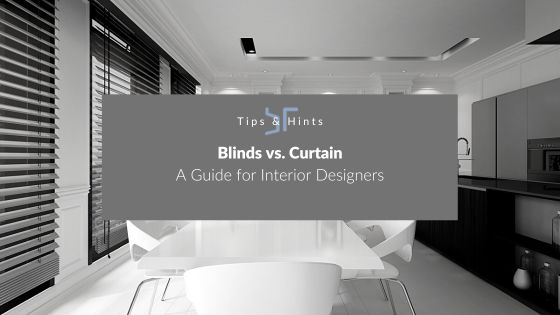Please wait...
Blinds vs Curtains: A Guide for Interior Designers
This entry was posted 16/05/2023

As an interior designer, you understand the significance of selecting the perfect window treatment to enhance the overall aesthetics and functionality of a space. When it comes to choosing between blinds and curtains, it's important to consider various factors such as style, functionality, and client preferences. In this article, we will delve into the differences between blinds and curtains, helping you make informed decisions when advising your clients on the ideal window treatment for their homes.
Blinds are a popular choice in modern interior design due to their sleek and minimalist appeal. Available in a range of materials including wood, aluminium, and vinyl, blinds offer versatility and a clean-lined look that complements contemporary spaces. They come in various styles such as Venetian blinds, vertical blinds, and roller blinds, each offering unique features and functionalities.
One of the key advantages of blinds is their exceptional light control. Clients who prioritise precise control over natural light will find blinds to be an ideal option. With a simple twist of a wand or pull of a cord, the slats can be adjusted to allow the desired amount of light into the room. This makes blinds a practical choice for areas such as home offices, bedrooms, and media rooms, where light management is crucial.
Blinds also excel in terms of maintenance. Unlike curtains, which require regular washing or dry cleaning, blinds can be easily cleaned with a damp cloth or duster. This convenience is particularly appealing for clients with busy lifestyles or those with allergies, as blinds are less likely to accumulate dust and allergens.
Curtains, on the other hand, offer a wider range of design options and can make a significant impact in transforming the look and feel of a space. With an extensive selection of fabrics, patterns, and textures, curtains provide opportunities for creative expression and can become a focal point in a room's design.
One of the standout benefits of curtains is their ability to provide insulation. The fabric and lining of curtains can help regulate temperature by keeping spaces cooler in the summer and warmer in the winter. This feature is particularly advantageous for clients living in regions with extreme weather conditions or those seeking to enhance energy efficiency.
Curtains also offer superior sound insulation, which can be crucial for clients living in noisy environments or those looking to create a tranquil atmosphere. The thickness and density of curtains can help minimise external noise, providing a peaceful environment for relaxation or work.
When considering the cost aspect, blinds generally tend to be more budget-friendly, especially basic designs and materials. However, high-end blinds made from premium materials can be more expensive. On the other hand, curtains offer a wider price range depending on the fabric, length, and design intricacy. Custom-made curtains or those crafted from luxurious materials can be quite costly, while ready-made curtains are more affordable options.
As an interior designer, it's essential to understand your clients' preferences and the specific requirements of each space before recommending blinds or curtains. Some clients may prioritise functionality and a modern aesthetic, making blinds the ideal choice. Others may value the versatility and softness that curtains bring to a room. In certain cases, combining blinds and curtains can provide the best of both worlds, allowing for optimal light control and design versatility.
When working with clients, take into account factors such as the room's purpose, the desired atmosphere, existing decor, and the client's lifestyle and preferences. By carefully considering these aspects, you can help your clients make informed decisions that align with their style, needs, and budget.
In conclusion, as an interior designer, understanding the differences between blinds and curtains is crucial in order to guide your clients towards the right window treatment choices. Balancing style, functionality, and client preferences is key to creating spaces that are not only visually appealing but also practical and comfortable. Whether you opt for blinds, curtains, or a combination of both, selecting the ideal window treatment will contribute significantly to the overall success of your design projects.
This entry was posted on 16/05/2023





